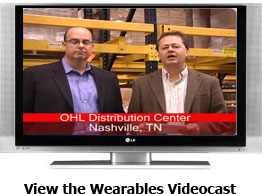 Cliff Holste, Materials Handling Editor Cliff Holste, Materials Handling Editor
| |
SCDigest Says: |
| |
 Ulery noted that the wearables have held up very well, and may actually suffer less damage than handhelds since users don’t put them down, drop them on the floor, etc.. Ulery noted that the wearables have held up very well, and may actually suffer less damage than handhelds since users don’t put them down, drop them on the floor, etc..

Click Here to See Reader Feedback
|
The hands-free benefits of voice technology have led to the tremendous growth in recent years in interest in and adoption of voice-based solutions in distribution applications.
But there is a hands-free alternative to voice that is also getting a stronger look: “wearable” terminals that are generally word on an operator’s arm, giving him or her availability of hands to use for picking or other tasks without the need to put a traditional handheld terminal down.
SCDigest believes logistics and distribution managers should often include wearables in the mix when looking for hands-free systems, and recognize that it is possible to deploy wearables with voice capabilities built in for multi-modal applications.
In a recent Videocast on Supply Chain Digest and the Supply Chain Television Channel, Robert Ulery, former director of engineering at logistics service provider OHL (who has since accepted a position with Johnson Stephens Consulting), said that OHL’s implementation of wearable devices (from Motorola) delivered significant productivity gains over the handhelds devices they had been using – and perhaps surprisingly, some improvement over voice terminals as well.
(To see the full videocast, go to: The Rise of Wearables in Distribution Applications.)
Ulery did engineering studies to measure the impact of moving from traditional handheld terminals in picking operations to the wearables, and found a 25% gain in piece picking and a 20% gain in case picking, consistent with a pilot project before implementation.
“We had a pretty neat opportunity here where we were able to test with a stop watch and engineered standards both the old way of doing it with the handhelds and the new way with the wearables,” Ulery said. “We did it in the same environment, with the same pick layout, same people, same products.”
 The improvements over use of handhelds is not surprising for several reasons, Ulery said. The videocast, for example, shows several lives scenes of OHL order pickers using both the wearables and the traditional handhelds, and clearly illustrates the benefits of having both hands available to pick multiple items, open cases, move cases into the pick position, and other tasks required during the picking process (see picture from videocast below). The improvements over use of handhelds is not surprising for several reasons, Ulery said. The videocast, for example, shows several lives scenes of OHL order pickers using both the wearables and the traditional handhelds, and clearly illustrates the benefits of having both hands available to pick multiple items, open cases, move cases into the pick position, and other tasks required during the picking process (see picture from videocast below).
The improvement over voice technology, which OHL was also using in some of its DCs, was perhaps more surprising. During the Q&A following the broadcast, Ulery said he attributed the 10% improvement using wearables to the fact that operators sometimes had to wait a bit for the next voice prompt to come, and/or to have the voice command repeated if they were unable to understand it the first time due to DC noise or other factors.
Plug and Play Implementation
Ulery said that while the opportunity to improve productivity over the existing handhelds was the main driver behind the replacement project, the fact that in their case, literally no IT resources were required for the project helped speed it along internally.
(Distribution Article - Continued Below)
|